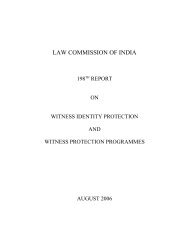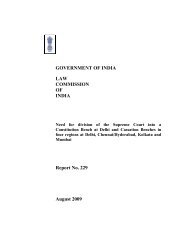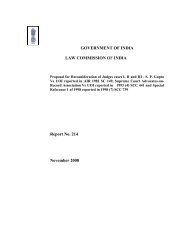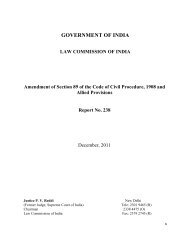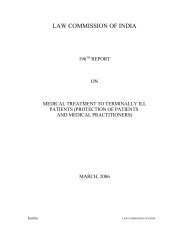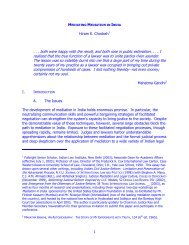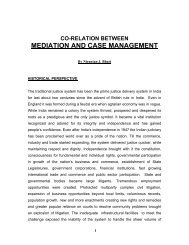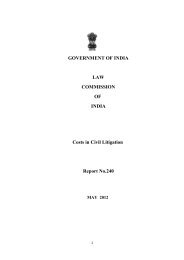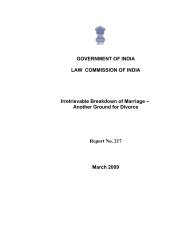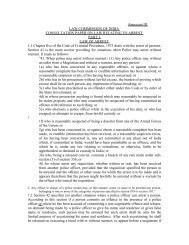COURT ANNEXED MEDIATION - Law Commission of India
COURT ANNEXED MEDIATION - Law Commission of India
COURT ANNEXED MEDIATION - Law Commission of India
Create successful ePaper yourself
Turn your PDF publications into a flip-book with our unique Google optimized e-Paper software.
and may imagine the unavailability <strong>of</strong> sufficient funds to introduce themachinery in the country. However, for a country which provided large priorityfunds for establishing fast track courts for expeditious disposal <strong>of</strong> criminalcases in the recent past, it is not impossible to make budgetary provisions fora beneficial cause, which, in the long run, can solve one <strong>of</strong> the naughtiestproblems <strong>of</strong> a fast developing country. If court annexed mediation programmecan be implemented with a determination, it will enable the country to carryout a major legislative intent and provide to the nation a stimulant for thegrowth <strong>of</strong> its commerce, industry and global interests. It will provide a newand fresh solution to the ailing problem <strong>of</strong> delays in the court. The presentdelay in disposal <strong>of</strong> the cases is mounting in a geometrical proportion andlikely to create a crisis <strong>of</strong> confidence and therefore, it requires a resolutedetermination and strong will to introduce the court annexed mediation in the<strong>India</strong>n legal system at the beginning <strong>of</strong> twenty-first century. The task is noteasy but not impossible. In USA it took 20 years to gradually introduce anddevelop mediation as a comprehensive court system. In <strong>India</strong> theestablishment <strong>of</strong> lok adalat and the administrative machinery forimplementation there<strong>of</strong> has also taken almost 20 years. The lok adalat is nowonly one <strong>of</strong> the ADR mechanisms implemented in the country. Thougharbitration is used privately by parties it has not really been expeditious andhas proved very expensive. Since the law has now contemplated variousalternatives for dispute resolution mechanisms including mediation, separatestate machinery for providing mediation can be very useful. The legislativeforesight and the global acceptance <strong>of</strong> court annexed mediation providesufficient justification for its introduction in the system. It is necessary,however, to first introduce the court annexed mediation in a few selectedcourts as pilot projects and watch, monitor and analyze its advantages andsuccess rates. This will require <strong>India</strong>n legal visionaries and ableadministrators to work together and evolve a scheme to provide an additionallegal service in the form <strong>of</strong> the court annexed mediation. A judicial council toestablish pilot programmes and to assess the benefits would be a prudent6
service quality and stimulates public respect. As a result the trainingprogrammes should be designed not only to enhance performance but also toinstill the values <strong>of</strong> the impartiality, pr<strong>of</strong>essionalism, competency, efficiencyand public service.”Mediators should not use coercive, authoritative and intimidating techniquesthat are used by untrained mediators. Some judges use authoritativeinfluence in judicial settlements, and it is therefore opined in some quartersthat judges do not make good mediators. However, in <strong>India</strong> there could bemore public acceptance <strong>of</strong> retired judges acting as mediators because <strong>of</strong> theirmultiple years <strong>of</strong> judicial experience. If such retired judges can be invited tobe on the panel <strong>of</strong> the court annexed mediators in <strong>India</strong> with minimum basictraining to change their mind set for their intended role <strong>of</strong> mediators, theirservices can be utilized with advantage. In the words <strong>of</strong> Hon’ble Benjamin F.Overton, a retired Chief Justice <strong>of</strong> Florida Supreme Court, “Judges are themost experienced neutrals in the justice system and should be excellentmediators but they need to fully understand the process and know when tobite their tongue and eliminate their authoritative face”.The court annexed mediators can also include experienced lawyers at thebar, law pr<strong>of</strong>essors, leading and respected businessmen and even the retiredbureaucrats. However a basic training for mediators, from whichever classthey are chosen, would be essential.An administrator for the court annexed mediation can seek the services <strong>of</strong>experienced lawyers who have taken basic mediation training and persuadethem to spare a given time for accepting mediation assignments. Thepayment schedule for mediators can be fixed, though it may be possible toobtain pro bono services <strong>of</strong> some lawyers in <strong>India</strong>. The experience <strong>of</strong> othercountries suggests that the parties who are referred to mediation are asked tocontribute towards mediation expenses including mediation fees. If the parties8



